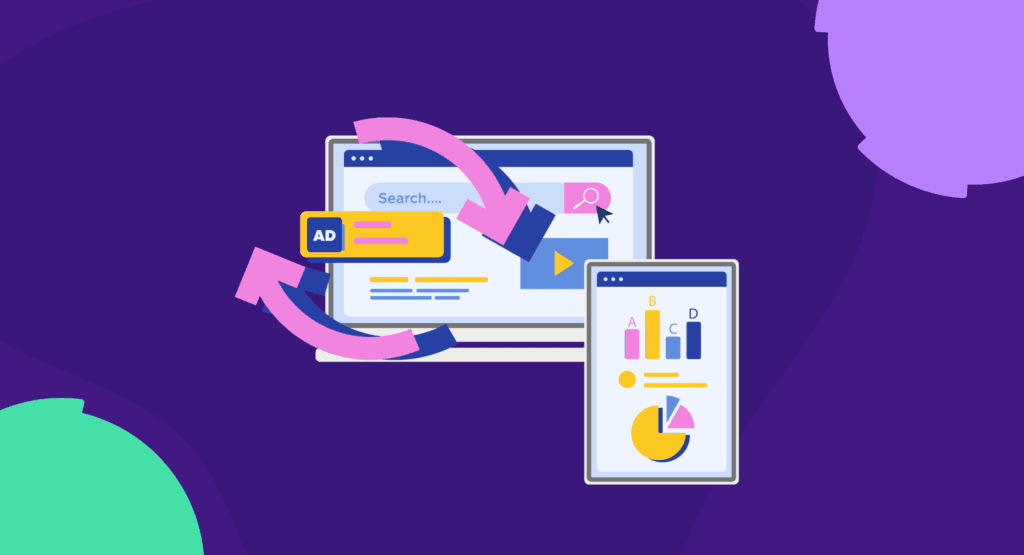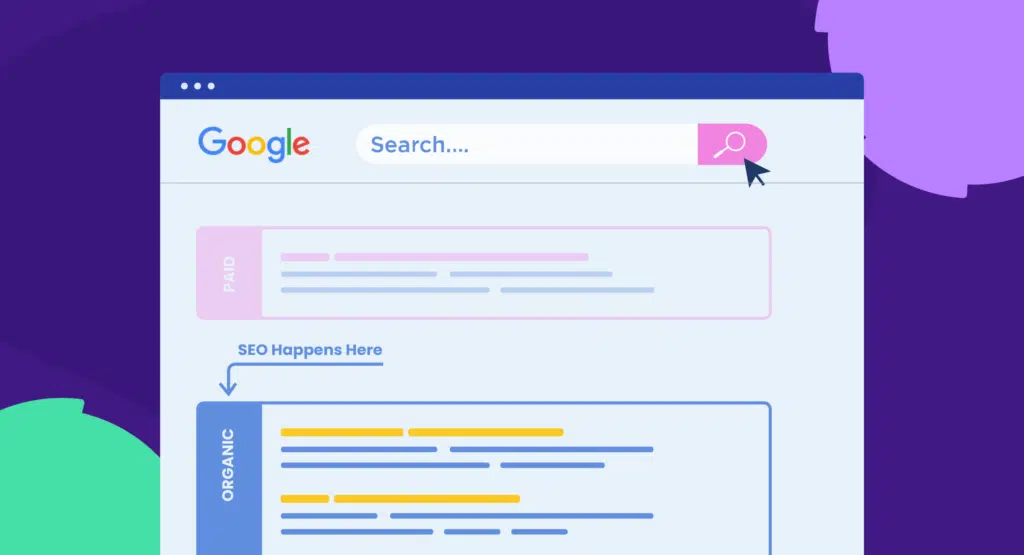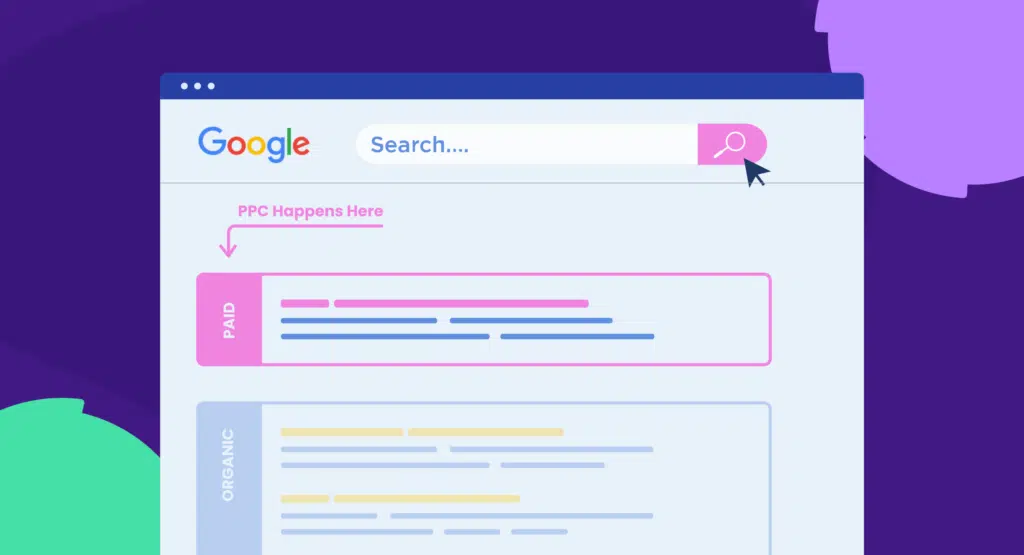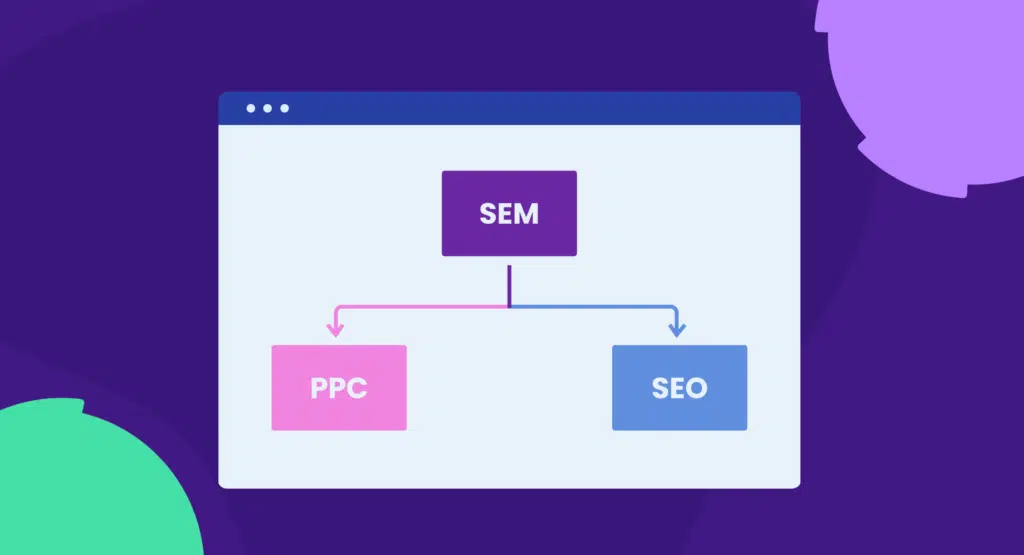
As SEO professionals, we know the devil’s in the details — and the line between SEO vs. SEM is more than just semantics.
It’s all about organic growth and paid visibility — and what could be more important when we’re battling Google? Especially when you’re trying to hit those SEO KPIs.
SEO and SEM are familiar terms to us. But do you know how the two fit together and which one you should choose for your site and your goals?
Let’s take a careful look at SEO vs. SEM, where PPC fits in, and how to pick the right strategies for your situation.
What Is SEO and What Is SEM?
The primary difference between SEO vs. SEM is that SEO focuses on fine-tuning a website to get free organic search traffic.
On the other hand, the goal of SEM is to get traffic from both organic and paid search.
For example, Google’s SERPs are divided into two sections: paid search results and organic results.

SEO optimizes your site to rank higher in organic search results.

You can also use pay-per-click (PPC) advertising to get your website into the paid area of SERPs.
PPC allows you to bid on keywords and display ads that appear above organic results, providing an additional pathway for visibility.

Right now, I’m betting you probably spend a lot of your time on SEO, focusing on ranking in the organic results. You might also venture into SEM, using both SEO and PPC to get traffic from search engines.
Technically, SEO best practices fall under the broader umbrella of SEM.

Now that you have a basic understanding of these two terms, let’s dig deeper into the biggest differences between SEO vs. SEM.
An Overview of SEO
SEO optimizes a website to make it more visible in search engines and earn more organic traffic.
The four main categories of SEO are:
- On-page SEO: Involves optimizing elements on your site for specific keywords. For example, you can include keywords in your content, images, keywords, and meta descriptions. How do you find just the right keywords? Check out our list of the best keyword research tools.
- Off-page SEO: Refers to activities outside your website that affect rankings. The most common off-page SEO technique is building backlinks from other websites.
- Technical SEO: Deals with the website’s infrastructure. With technical SEO, your job is to ensure search engines can crawl and index your site efficiently. So you’ll make sure your pages load quickly, your site architecture is correct, and there are no 4xx errors.
- User Interaction Signals: How does Google know if your page is a good match for someone’s search? It can take cues from your users by watching click-through rates (CTRs), time spent on site, and bounce rates. To influence this part of SEO, optimize your pages and ensure they’re an ideal fit for people who land on your site from specific keyword searches.
Local SEO optimizes a website to increase visibility in search results for local-specific queries.
It targets users in a specific geographic area and helps businesses be more visible to local customers looking for their products or services.
From meta descriptions to internal linking, Semrush’s Site Audit tool will give you a complete picture of your site’s health and offer actionable recommendations to improve your SEO.

An Overview of PPC
Pay per click (PPC) is an important part of SEM that helps businesses quickly boost their visibility.
How?
By paying for top spots on search engine results pages (SERPs).
Unlike SEO — which takes time to show results — PPC provides instant results, making it ideal for competitive keywords.
PPC ads show up above organic search results, leading users straight to the most relevant pages.

This strategy is highly targeted. It allows you to define your audience based on demographics, interests, location, and behaviors.
All this ensures your ads reach the right people.
Your bid, budget, and ad quality determine where your ad appears on SERPs.
PPC platforms also give you valuable data to track how well your ads are performing.
You can adjust your bids, track performance, and optimize for keywords that bring in the most clicks.
Tools like Semrush’s Keyword Magic Tool and Ads History help you analyze competitor strategies. This data-driven approach makes PPC an effective way to boost traffic both in the short and long term.
Within SEM, PPC is a powerful, targeted approach to reaching audiences precisely when and where they’re searching.
An Overview of SEM
SEM encompasses all strategies that enhance your visibility on SERPs, including both organic and paid methods.
SEO helps improve rankings by making content and technical changes, while PPC lets you get quick visibility by paying for top ad spots.
This approach allows you to secure prominent positions on SERPs by bidding for keywords and defining target audiences.
For example, when you search for “meditation apps,” Headspace shows up first in the PPC results and first in the organic results:

But SEM isn’t just limited to PPC. These can also fall under the same umbrella:
- Display ads are visuals that appear on a wide variety of websites. They can be static images, GIFs, or even video ads. They don’t appear on search engine results pages but are part of the broader SEM strategy because they target users based on their search behavior.
- After someone visits your site, remarketing strategies enable you to show ads to that person as they visit other sites around the web. Yep, sometimes it’s creepy. But the idea is that you’re reminding users of their interest in your product or service and trying to get them back to your site so they can take action.
- Direct advertisement involves purchasing ad space directly from a website rather than going through a third-party system like Google Ads. For example, you might negotiate directly with a popular blog in your industry to have an ad for your site appear on their site.
Need that in a nutshell?
Here it is:
SEM combines the power of organic reach (through SEO) with paid strategies (like PPC, display ads, remarketing, and direct advertisement) to give you a comprehensive approach to search engine visibility.
So if you want to pay for search traffic as part of your SEM strategy, you might wonder what’s involved in that process.
Here are the basics:
- Start by identifying the keywords you want to build your PPC campaigns around. Semrush offers a number of helpful keyword optimization tools — more on that below.
- By bidding, you set the maximum amount you’re willing to pay for a click on your ad. The actual amount you pay might be lower based on competition and other factors. Your bid helps determine your ad’s placement relative to other advertisers.
- Targeting means selecting specific demographics, behaviors, or contexts where you want your ads to show up. By refining your target audience, you ensure your ads are shown to the most relevant users. You can target based on age, location, interests, search queries, and more.
Semrush’s Keyword Magic Tool can help you identify the right keywords to bid on in your paid ad campaigns.
Inside the tool, enter a word or phrase that’s relevant to your site, and hit “Search.”

The Keyword Magic Tool will display potential keyword ideas for your PPC campaigns.

Not all of these will be a good fit for your campaigns. In general, choose the words or phrases that are most likely to convert.
Do this by looking at keyword search volume, keyword difficulty, and cost per click (CPC).
The Ads History tool in Semrush provides insights into your competitors’ advertising strategies.
It can help you identify new opportunities, streamline your campaigns, and save time and money.

Read our Semrush review to learn more about the platform’s extensive PPC features.
What Is the Difference Between SEO and SEM?
Search engine optimization (SEO) focuses on improving organic search rankings through content optimization and technical adjustments. Search engine marketing (SEM), on the other hand, includes both SEO and paid advertising. It combines these strategies to increase visibility and attract targeted traffic from search engines.
Many discussions in SEO communities often overlap with SEM, as both are essential for maximizing visibility and engagement.
Let’s dive deeper into what sets SEO and SEM apart.

SEO vs. SEM: The Timeline for Traffic
SEO is a marathon. Even if you’re an experienced professional with a reputable SEO business, it’ll take time for you to bring in traffic. This is especially true if your site is new and you don’t have a lot of backlinks.
It can even take years before you rank on the first page of Google. And even with consistent effort, there’s no guarantee you’ll make the coveted top spots for highly competitive keywords (or keep them once you have them).
But don’t despair! If you target long-tail keywords and implement best practices for SEO copywriting, you can start to see results in a few months.
On the other hand, you can get near-instantaneous results if you focus on PPC as part of your search engine marketing strategy. You write some ad copy, start the engine on your search ads, and get traffic and conversions in just a few hours.
That doesn’t mean you’ll see an instant ROI, though. You’ll need to test and tweak your ads consistently to get a positive ROI from PPC campaigns.
But there’s no doubt: PPC does start working much more quickly than traditional SEO.
SEM vs. SEO: The Financial Investment
SEO predominantly involves indirect costs.
While you might not be paying for every click or view, you’re still shelling out for that traffic in terms of time and resources.
You might hire experts to optimize your site or invest in link-building tools. Over time, these costs can add up.
You’ll also need to consider the time and effort spent creating content, backlink outreach, and optimizing your website.
For SEO, the complexity of your website, the competition in your industry, and the region or market you’re targeting can all affect your expenses.
For instance, aiming to rank for a keyword like “best digital marketing tools” will be far more competitive (and likely more expensive) than a more niche keyword like “best tools for bonsai tree care.”

PPC has direct costs attached.
You pay per click, so depending on the competitiveness of your keywords, these costs can range from a few cents to several dollars per click.
Factors such as the quality of your ads, how well your landing pages perform, and the regions you’re targeting can all impact the cost of PPC.
If you’re advertising a luxury product in a high-income region, expect higher costs per click than a common household product.
Setting a PPC budget will help you control spending, but you’ll need to continually monitor and adjust your campaigns to ensure they’re cost-effective.
And if you stop spending on PPC ads, the faucet will turn off immediately, and your traffic will stop.
But cost shouldn’t be the only factor. It’s also about value.
SEO can provide long-term, sustainable traffic at a (relatively) fixed cost. On the flip side, SEM can offer you immediate traffic, but costs can fluctuate based on competition and market dynamics.
Balancing the two ensures immediate visibility and sustained long-term presence in search engines. To refine your approach, check out Traffic Think Tank Academy for expert guidance on your SEO and SEM strategies.
SEO vs. SEM: Attracting the Right Visitors
With SEO, the traffic is naturally targeted. Users actively search for specific terms or questions that your content addresses.
If your site ranks well for relevant keywords, it means the visitors coming to your site are looking for the information you provide.
If you play your cards right, this organic traffic can lead to excellent engagement and high conversions.
SEM, especially through PPC campaigns, also allows for precise targeting.
Advertisers have the ability to define their audience based on demographics, interests, behaviors, and more. By setting these parameters, the ads are displayed only to people who fit the profile you’ve created.
Traffic from PPC can be highly targeted. However, it’s important to constantly refine and optimize your ad campaign parameters to keep it relevant.
The goal is to draw in visitors who are genuinely interested in what you offer. Properly executed, both strategies can drive highly targeted traffic to your website.
SEO vs. SEM: Long-Term Traffic Potential
The entire goal of SEO is to get sustained organic traffic. Once a web page has ranked well for specific keywords, it can continue attracting consistent visitors without additional spending.
However, maintaining your ranking requires ongoing optimization efforts, especially in competitive niches.
Sudden drops in traffic can occur due to algorithm changes or increased competition, so you’ll need to keep a close eye on your website traffic over time.
Use Semrush’s free website traffic checker to monitor your traffic over time, head those algorithm changes off at the pass, and maintain your rankings.

PPC campaigns can deliver large volumes of traffic in short bursts. As long as you’re willing to pay for the clicks, the traffic keeps coming — but again, the moment the budget dries up or the campaign ends, this traffic source stops.
You can maintain consistent traffic through PPC. However, it requires a steady budget and ongoing campaign management.
In the long run, SEO offers more stable and sustained traffic, albeit with a slower start. PPC (as part of SEM) provides the advantage of immediate results, but its longevity relies on ongoing investment.
SEO and SEM Strategies: How to Pick the Best One for Your Goals
Understand the primary difference between SEO vs. SEM? Great.
Next, I’ll help you determine when and where to use each.
When to Choose SEO
SEO is your best option if you’re operating on a tight budget or offering products that aren’t conducive to traditional marketing methods.
If your business model has narrow margins, like in dropshipping, the consistent costs of PPC might need to be revised.
Additionally, if time is on your side and you don’t need instantaneous results, SEO is the logical choice.
Regardless of your chosen strategy, working on SEO as early as possible (preferably as soon as you launch your site) is highly beneficial. It’s a long game, but many SEO case studies show long-term results.
When to Choose SEM
Use SEM when you have a budget specifically allocated for paid marketing. It’s especially effective if you clearly understand your target audience’s demographics, behaviors, and interests.
If you’re selling a high-volume product where the costs of PPC will maintain your profit margins, SEM can be your go-to strategy for quicker visibility and conversions.

When to Choose Both
Generally, if your product is suitable and you have the budget, choosing both is the best strategy. SEO and SEM work together to ensure immediate and long-term online visibility.
SEM can enhance brand visibility by supporting SEO efforts. It drives traffic to SEO-generated content, which can also accrue backlinks through SEM promotions.
Together, these strategies can maximize your online presence and boost conversions.
Bring SEO and SEM Together
As you can tell by now, this isn’t really an SEO vs. SEM debate.
Choosing between the two isn’t an either/or — it’s about finding the right balance for your goals.
Whether you’re crafting a long-term organic strategy or looking for paid results (or both!), Traffic Think Tank Academy offers expert resources and guidance to help you master SEO and SEM.
Join the TTT Academy today and start taking your marketing skills to the next level!
Semrush
- Semrush – Best overall SEO functionality
- Google Search Console – Best free (partial) data from Google
- Advanced Web Ranking – Best for reporting
- SERPWatcher by Mangools – Best for bloggers and small teams
- Ahrefs – Best for keyword analysis
- SEO PowerSuite – Best affordable option
- SEO Monitor – Best for forecasting
- Local Viking – Best for local SEO map tracking
- Nozzle – Best for data visualization
- ProRankTracker – Best for agencies and SEO professionals